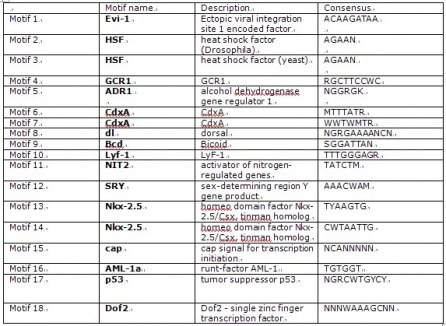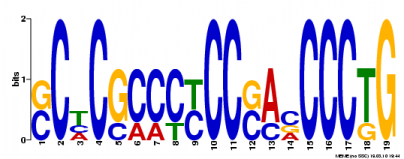This web page was produced as an assignment for Genetics677, an undergraduate course at UW-Madison.
Gene motif
Using mRNA form
Following infromation retrieved from MOTIF (website)
85 (cutoff) : 198 motif found
90 (cutoff): 110 motif found
95 (cutoff): 52 motif found
97 (cutoff): 29 motif found
99 (cutoff): 18 motif found
Following infromation retrieved from MOTIF (website)
85 (cutoff) : 198 motif found
90 (cutoff): 110 motif found
95 (cutoff): 52 motif found
97 (cutoff): 29 motif found
99 (cutoff): 18 motif found
I used different cutoff to obtain different number of motifs in my gene. Cutoff at 99 gives 18 different motif, and I decided to used those 18 motifs to study my gene related to pulmonary arterial hypertension. Motif 13 and 14 have same motif name and its function, but have different consensus. This applies to motif 6 and 7. There were two motifs that have the function as heat shock factor in different organisms, Drosophila and yeast. The census for both motif are same. I might consider to study the motif 11 further because pulmonary arterial hypertension (PAH) is highly associated with the concentration of oxygen (McLaughlin et al 2009). Nitrogen may be another factor that may be associated with PAH, so it would be worth to study this motif in future study.
Following information and figure retrieved from MEME
MOTIF 1: width = 50 sites = 5 llr = 239 E-value = 2.1e-013
Following information and figure retrieved from MEME
MOTIF 1: width = 50 sites = 5 llr = 239 E-value = 2.1e-013
The first motif that is retrieved from MEME is shown. It indicates that the e-value is 2.1e-013 consisting with the width of 50 nucleotides and occurs at 5 sites. Furthermore, the log likelihood ratio (llr) is indicated as 208. This first motif has the smallest e-value from all three motifs I obtained from MEME.
MOTIF 2: width = 50 sites = 5 llr = 208 E-value = 4.8e-004
MOTIF 2: width = 50 sites = 5 llr = 208 E-value = 4.8e-004
The second motif that is retrieved from MEME is shown. It indicates that the e-value is 4.8e-004 consisting with the width of 50 nucleotides and occurs at 5 sites. Furthermore, the log likelihood ratio (llr) is indicated as 208. This second motif has the second smallest e-value from all three motifs I obtained from MEME.
MOTIF 3: width = 19 sites = 4 llr = 87 E-value = 3.0e+003
MOTIF 3: width = 19 sites = 4 llr = 87 E-value = 3.0e+003
The last motif that is retrieved from MEME is shown. It indicates that the e-value is 3.0e+003 consisting with the width of 19 nucleotides and occurs at 4 sites. Furthermore, the log likelihood ratio (llr) is indicated as 87. This third motif has the biggest e-value from all three motifs I obtained from MEME.
I used two tools to measure motifs of the gene sequence of BMPR2. I firstly tried with my original DNA sequence, however, I could not obtain any result due to its long and large sequence. Therefore, I had to substitute with the predicted mRNA based on my original gene sequence.
Both tools—Motif and MEME—have advantages and disadvantages to use. Motif nicely gives out the name of each motif and its correlated function. The motif census is consisted of about 8-10, while MEME gives out a longer sequence to compare (about 20 nucleotides). However, Motif did not give any statistical value, while I could obtain e-value from MEME for each motif. In my personal opinion, I hope there is another tools that bind Motif and MEME to interpret the data results. Or if MEME can add each motif’s detail function addition to their nice statistical analysis, it would be nice to use it.
I used two tools to measure motifs of the gene sequence of BMPR2. I firstly tried with my original DNA sequence, however, I could not obtain any result due to its long and large sequence. Therefore, I had to substitute with the predicted mRNA based on my original gene sequence.
Both tools—Motif and MEME—have advantages and disadvantages to use. Motif nicely gives out the name of each motif and its correlated function. The motif census is consisted of about 8-10, while MEME gives out a longer sequence to compare (about 20 nucleotides). However, Motif did not give any statistical value, while I could obtain e-value from MEME for each motif. In my personal opinion, I hope there is another tools that bind Motif and MEME to interpret the data results. Or if MEME can add each motif’s detail function addition to their nice statistical analysis, it would be nice to use it.
Reference
[1] McLaughlin, V., Archer, S., Badesch D., Barst, R., Farber, H., Lindner, J., Mathier, M., McGoon, M., Park, M., Rosenson, R., Rubin, L., Tapson, V., & Varga, J. (2009) ACCF/AHA 2009 Expert Consensus Document on Pulmonary Hypertension. Journal of the American College of Cardiology 53, 1573-1619. doi:10.1016/j.jacc.2009.01.004
[1] McLaughlin, V., Archer, S., Badesch D., Barst, R., Farber, H., Lindner, J., Mathier, M., McGoon, M., Park, M., Rosenson, R., Rubin, L., Tapson, V., & Varga, J. (2009) ACCF/AHA 2009 Expert Consensus Document on Pulmonary Hypertension. Journal of the American College of Cardiology 53, 1573-1619. doi:10.1016/j.jacc.2009.01.004




